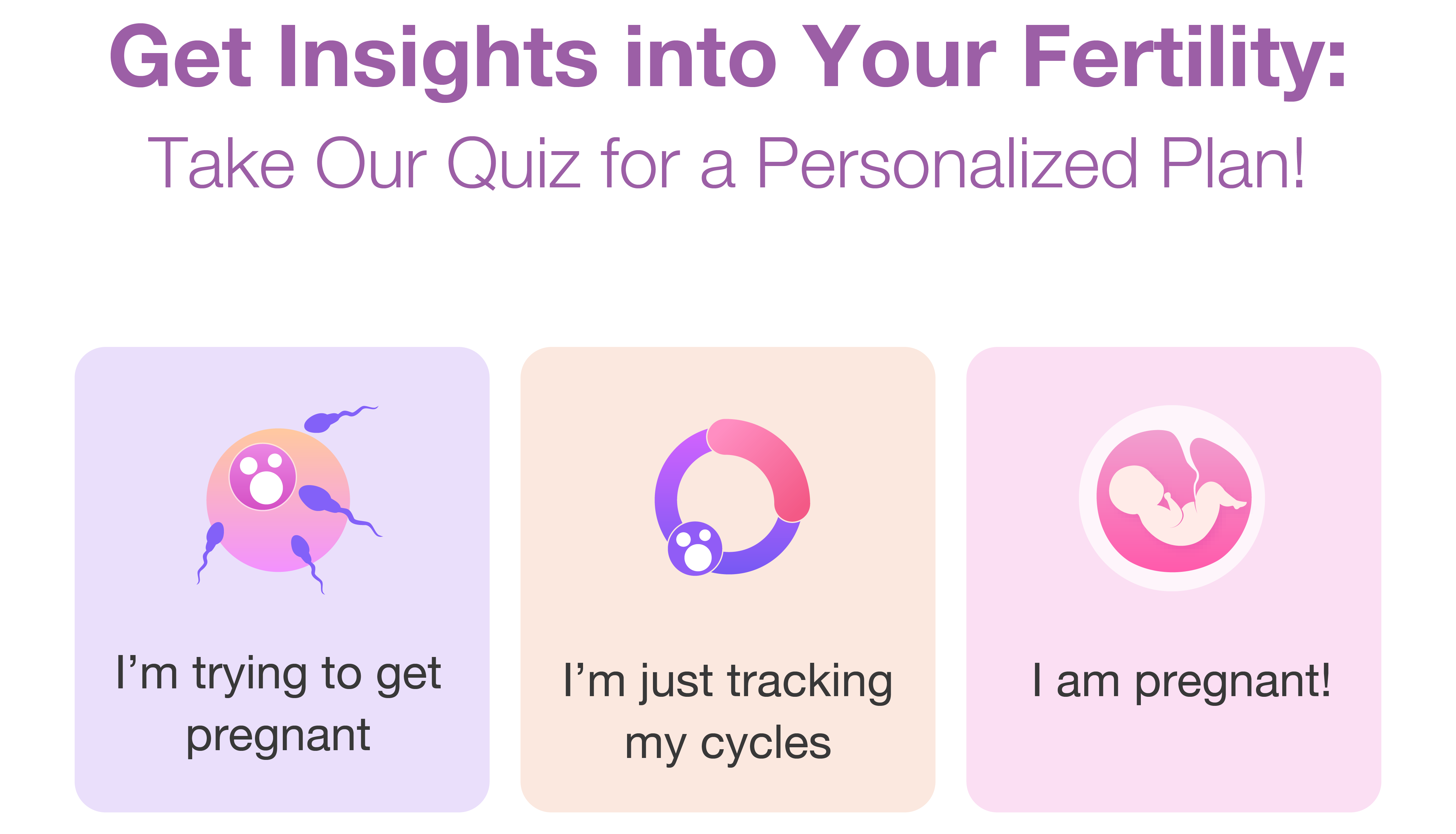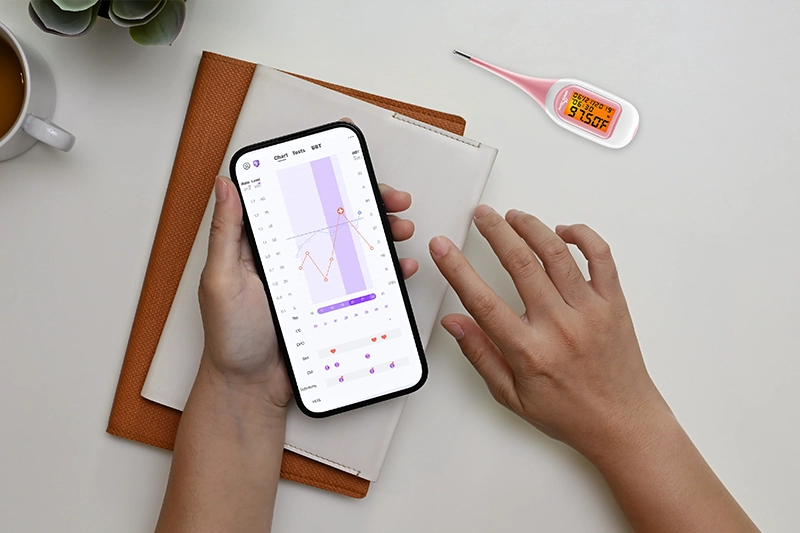Are you trying to conceive or wondering if you might be pregnant? Your BBT chart can tell you a lot about your fertility especially whether you are pregnant or not. From understanding the basics of when BBT drops or rises and how to interpret your chart, we can uncover everything you need to know to use this powerful tool on your fertility journey.
What is basal body temperature?
Basal Body Temperature (BBT), is the lowest temperature of your body at complete rest. BBT changes throughout the menstrual cycle, reflecting fluctuations in hormone levels. During the first half of the cycle, estrogen dominates and causes the body to produce more cervical mucus, which creates a lower, more stable BBT.
After ovulation, progesterone takes over and causes a slight increase in temperature. Resting temperature is best measured first thing when you wake up in the morning before you get out of bed, eat, drink, walk or talk.
How to use BBT to confirm ovulation
Throughout a woman’s cycle, BBT typically follows a pattern of being lower before ovulation and then rising after ovulation due to the hormonal changes that occur during the menstrual cycle. As the hormone progesterone increases after ovulation, BBT also naturally rises anywhere from 0.5 – 1 degree Fahrenheit (0.3-0.6 degrees Celsius) higher than pre-ovulatory temperatures. You will want to use a special basal thermometer to check your temperature each time right when you wake up and document your readings, which you can easily do right in the Premom app.
When tracking BBT, you will notice a rise in temperature anywhere from 1-3 days after ovulation once progesterone is released. This rise in temperature indicates ovulation has successfully occurred which makes BBT a great tool at helping to confirm when ovulation happens!

BBT chart when pregnant vs not pregnant
Progesterone naturally decreases right before a new cycle begins and you begin your period. If you are not pregnant while it remains elevated if you are pregnant; meaning BBT can actually be a clue to early pregnancy!
So, what does a BBT pattern normally look like when not pregnant versus when you are pregnant?
Here is what a BBT chart looks like if you are not pregnant…

If pregnancy does not take place, your BBT chart will typically show a drop in temperatures again a day or two before your next menstrual period begins. This BBT drop is due to the decrease in progesterone levels in your body, which occurs when you do not conceive during that menstrual cycle. If you are tracking your BBT consistently throughout your luteal phase (second half of menstrual cycle), you may notice a dip in BBT right before the start of your next period, or even the days before your period begins.
Here is what a BBT chart when pregnant would look like…

When you become pregnant, your BBT chart will typically show a sustained rise in temperature due to the increased production of progesterone in your body, which helps support the pregnancy. Typically in early pregnancy, progesterone should not be dropping, therefore your temperatures typically do not drop either. This sustained increase in temperature on the BBT chart can be a strong indicator of pregnancy, particularly if it persists for at least 15 days after ovulation. However, it’s important to note that not all women will experience a sustained temperature rise and some may have other symptoms or signs of pregnancy.
It’s important to note that BBT charts can vary from person to person, and there is no single “pregnancy” or “non-pregnancy” chart that applies to everyone. However, these are some general trends that can be observed in BBT charts for pregnancy and non-pregnancy. A sustained increase in temperature for more than two weeks after ovulation is a common indication of pregnancy in a BBT chart.
How long does BBT stay elevated if pregnant?
During pregnancy, you won’t see a drop in BBT like you typically would right before the start of your period. Progesterone remains high throughout the pregnancy, meaning your temperature will typically stay high throughout the entire pregnancy as well. It is important to note that an elevated BBT result is not a definitive sign of pregnancy and if you believe you are pregnant, you should take a pregnancy test or call your healthcare provider.
Does BBT drop after implantation?
BBT does not drop after implantation, however some women might see a slight dip in BBT during the luteal phase, typically just for 24 hours around the time of implantation. This is related to a second surge of estrogen that happens in the luteal phase, and when estrogen rises, that causes BBT to drop slightly. Your temperature should go back up the following day and this quick dip is not anything to worry about.
There are many factors, such as illness, stress, alcohol intake, travel and changes in sleep patterns can affect your BBT temperature. It is important to remember that you want to look at the overall picture of your BBT in a cycle and not just one result because of the many factors that can affect your temperatures each morning.
You can easily keep track of your BBT readings in the Premom app and see the rise in temperature in correlation with your LH surge to see if and when you ovulated. This also allows you to easily see what happens to your BBT right before the predicted start of a new cycle, which could be an early indicator of pregnancy.

References
- Physiology, Ovulation and Basal Body Temperature- NCBI bookshelf. (2022). Retrieved, from https://www.ncbi.nlm.nih.gov/books/NBK556096/
- Grant, A., & Smarr, B. (n.d.). Feasibility of continuous distal body temperature for passive, early pregnancy detection. PLOS Digital Health. Retrieved from https://journals.plos.org/digitalhealth/article?id=10.1371%2Fjournal.pdig.0000034 Basal body temperature: Family planning method. Cleveland Clinic. (n.d.). Retrieved from https://my.clevelandclinic.org/health/treatments/21065-basal-body-temperature


